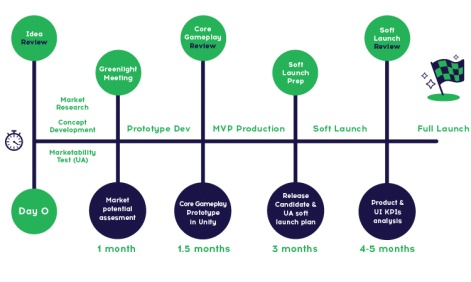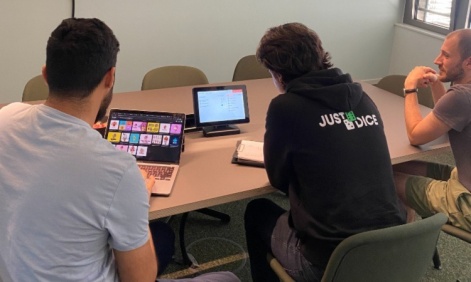Over the years, we’ve learned that new games are much more likely to succeed if a more dependable, iterative mobile game prototyping method is followed. One of our strategy's core values at justDice is the early validation of concepts, which enables our developers to identify potential issues and make necessary adjustments before they become more serious.
Implementing a gated 'greenlighting' procedure that uses key performance indicators (KPIs) to determine if the project should move forward is a crucial component of this approach. This allows more control and transparency over the development process and helps ensure the project stays on course and achieves its objectives.
Essentially, our game designers will be able to create better games that satisfy the needs of our players with an emphasis on early validation and a clearly defined greenlighting procedure.
Our Prototyping Process
At justDice, we want to guarantee that we:
- Efficiently produce fun and exciting games
- Ensure our high standards are met and exceeded
- Encourage freedom of thought and suggestions from all team members
- Constantly analyse and update our method to streamline it for future game production

How justDice prototypes a mobile game
1. Pitch & Concept Development
Every month, we organise at least one ideation pitch where our team members can present their game concepts. During this Q&A session, the teams pitch their ideas and the strongest concepts are considered for the concept and marketability phases.
In line with 'you imagine first before you build,' our process includes brainstorming, sketching concepts, analysing reference games, and honing ideas until a strong game foundation is achieved.
The steps taken into account are:
- Choosing the objective: We consider what the game will accomplish, its main gameplay loop, essential components, and any unique twists.
- Think of a target market: A successful game must cater to the needs of a target audience.
- Market potential analysis: Perform a market analysis on genre trends, prospective market sizes by GEO, and the competitive environment.
- Get inspired: Dive into existing games to determine what works and what doesn't.
- Refine: Adjust the rough idea until we have a solid game framework.
Marketability Test
Once the game foundation has been set, it’s testing time. And every level of our marketability tests has prerequisites that must be met to reach the next stage.
How It Works
One month into the development process, a gameplay video or playable ad is produced as part of the marketing strategy.
Developing an effective ad is crucial to attracting the target audience and highlighting the game's unique features and benefits. This may involve brainstorming ideas for characters, graphics, storyline, music, and other elements to create an engaging and memorable ad.
After finalising the concept, the team creates the gameplay video creative or playable ad. This involves designing and building a game prototype, creating visual and audio assets, and programming gameplay mechanics to provide an immersive, interactive experience that accurately reflects the game.
Subsequently, the user acquisition team conducts a marketability test to evaluate the game's potential for success and profitability, a standard game development and publishing practice.
How We Evaluate
Once the marketability test confirms 15,000 impressions, we will evaluate the results using our internal metrics: CTR and IPM.
After collecting the data, the greenlight meeting is held, a critical step to determine if the game's development is worth the investment and resources. Here, the game team evaluates the test's performance and potential alongside user acquisition.
2. Prototype Development
If the game meets and exceeds our standards, we move on to the prototype development phase, roughly 1.5 months into the process. The goal is to bring the idea to life and test the game using basic gameplay and core loops, nothing fancy.
3. Internal Testing
Next, we have internal testing, where justDice QA testers form focus groups with team members to check the new game before its public release. This valuable feedback helps identify any issues or areas of improvement before the game is promoted to the next stage: minimum viable product (MVP) development. Important factor: we try to make our groups as diverse as possible. Everyone with different gaming backgrounds, from everyday gamers to ‘what button do I press?’ are invited to give feedback.

4. MVP Development
Once the prototype is successfully tested and evaluated, we proceed to MVP development. We also conduct gameplay tests with external players using online tools to gather valuable feedback on the difficulty curve and player experience targets.
The games team will then review the data and feedback and compare results with our benchmark metrics. Normally, tasks will be divided into various priority levels and assigned to the relevant parties with realistic deadlines.
Coinciding with this, QA Testers will also:
- Identify and log bugs
- Verify fixes with developers
- Test the game’s balance
- Perform regression testing
5. MVP Soft Launch
After the MVP development phase, we have the MVP soft launch. This step determines whether the game has an audience by testing the waters in the gaming community. The team reviews the soft launch data after a few months live on the market. These metrics include:
- Retention rates
- Average playtime
- CM2
If successful, work begins on new features.

6. Next Feature Batch Launch
Next, we have the next feature batch launch. This software improvement strategy allows us to test and refine new features or updates in a controlled environment before they are fully released. This helps decrease the risk of issues or problems arising when significant changes are introduced to the game.
Conclusion
Our process continuously evolves, and we maintain an open dialogue with the team, encouraging new ideas, thoughts on process tweaks, and feedback on how we can improve. If you're interested in working in this environment, check out our open positions now and make justDice your next step!





















